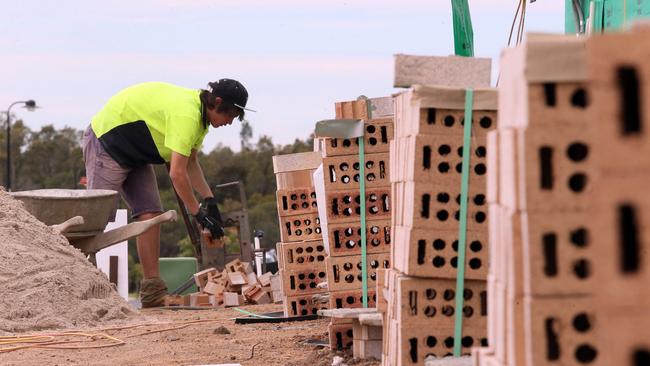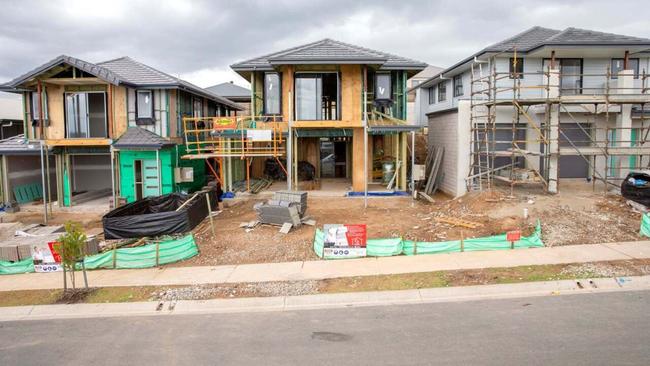Key stakeholders reveal the challenges slowing residential construction in NQ
With the Townsville region needing thousands of houses and workers over the next five years, industry stakeholders have explained what’s slowing residential construction.

News
Don't miss out on the headlines from News. Followed categories will be added to My News.
Townsville’s housing shortage looms as a massive challenge needed to be overcome if the city was to accommodate its growing population and tens of thousands of workers needed to deliver North Queensland’s multi-billion dollar pipeline of projects.
Industry stakeholders have pointed to a range of issues, including a skilled worker shortage, rolling out more trunk infrastructure, slashing red tape and regulations, reducing insurance costs, embracing alternative construction strategies, changing our tax settings, and boosting productivity.
Townsville Enterprise
Townsville Enterprise and key industry partners united last July to deliver a national liveability campaign called The Good Life to recruit an additional 27,000 skilled workers over the next five years to deliver the region’s pipeline of projects.
Townsville Enterprise Director Regional Development and Investment Chris McDougall said housing remained “the biggest challenge ahead” in delivering on the $42.2bn project pipeline for North Queensland, with an expected forecast of over 20,000 skilled workers needed.

“In collaboration with Townsville City Council, regional councils and our industry partners, we have identified a number of options to support housing developments – including trunk infrastructure tasks which are set to unlock thousands of shovel-ready housing lots in Townsville,” Mr McDougall said.
“Ultimately, the type or style of housing built in the region will be market-led, and we are supportive of all forms of investment in this space to ensure that our region can continue to unlock its potential.”
Master Builders Queensland
With Townsville expected to gain 31,000 more residents by 2036, Master Builders Queensland regional manager for North Queensland, Mark Vaughan, said the city was a prime example of the challenges faced by the construction industry.
Referring to KPMG’s Enterprising Cities report from May 2024, he said 27,000 new jobs were projected to be created in Townsville in the next five years, provided that the handbrake on the city’s housing shortage could be released.

But the Australian Bureau of Statistics reported that the North Queensland region experienced a 7.5 per cent decline in approvals of new detached homes and units in the three months to January, showing that we’re trending in the wrong direction
“The primary challenge for our industry right now is the shortage of skilled workers, which is now at a critical level,” Mr Vaughan said.
“Build Skills Australia reports that we need around 40,000 to 50,000 people to join our industry in Queensland, every year, to complete the huge pipeline of projects right across our sector – including the 2032 Olympic and Paralympic Games program.
“Right now, we’ve only got around 10,000 new workers joining our industry each year.”
He said we needed to encourage apprentices to stick with their training, to back small businesses to train young workers, and to get more women into the industry.
“Moving forward, we also need to have processes in place to make it easier for tradies from the other states and territories to have their qualifications recognised here in Queensland, so we can call on them to bridge the gaps and get the rebuild started and completed sooner, in the wake of severe weather events,” he said.
Mr Vaughan said the region’s existing trade shortage meant that completing the private and public sector work over the next five to 10 years could prove challenging.

“The proposed work includes the Townsville University Hospital expansion project, and a new water park development, beach club and complex, with the groundbreaking possibly due to start some time in 2025,” he said.
“That’s why we’re calling for the red tape hampering new construction to be slashed, and for measures to be taken to boost productivity.
“A good place (to cut red tape) will be for the government to make the accessible housing and energy efficiency changes in the National Construction Code 2022 no longer mandatory.”
He said they were pushing to scrap the frozen Best Practice Industry Conditions (BPIC) and Project Trust Accounts, and for the Queensland Building and Construction Commission to step up and work more fairly with the industry.
“Decisions should be based on the law and building codes, not personal opinions. Government procurement processes also need a revamp. Contractors deserve fair contracts, and tendering needs to be less of a headache,” he said.
Property Council of Australia
Property Council of Australia’s Queensland executive director Jess Caire said the issues plaguing the residential construction sector across Queensland were particularly problematic in regional areas such as Townsville, and would not dissipate overnight.
She said the challenges included the lack of skilled labour needed to build the houses and skyrocketing insurance costs, which eroded the feasibility of new developments.

“The biggest barrier to housing development over the last few years has been construction costs which are driven by productivity challenges and labour shortages within our workforce,” Ms Caire said.
“Labour shortages are particularly prominent in regional areas such as Townsville which have a shallower labour market.
“Furthermore, regional areas can get stuck in a vicious cycle where they require more workers to deliver housing, however, if in turn there is no available housing for workers to move into it is impossible to respond to the housing deficit.”
She said the silver lining was that regions like Townsville had more land in comparison to south east Queensland, providing the opportunity to increase supply but developing this land in the current market was not simple.
“There were 435 residential dwellings approved to be built in Townsville in the 2024-25 financial year – the lowest since 2019,” she said.
She said the Property Council was advocating for councils and the state government to pull all available levers to boost supply, including the adoption of Modern Methods of Construction, using a broad array of technologies and building methods.
“One area that the Property Council have been working with Townsville City Council on is unlocking development in Townsville’s city centre. There is a unique opportunity to deliver higher density development within the city core which will not only boost housing supply but also breathe life back into the city centre,” she said.
“It is imperative that Townsville ensures it not only increases housing supply to match demand but ensures that this new supply is delivered in the right areas so it can best be leveraged to help drive Townsville’s growth.”
She said housing supply could also be increased by accelerating the development of trunk infrastructure, streamlining planning processes to reduce development costs and speed to market, and for the state government to review the impact of foreign property tax settings which were disincentivising investment into housing.
Townsville City Council
A Townsville City Council spokesman said the housing supply shortage wasn’t unique to our region.
“The majority of new housing in Townsville is what is deemed as ‘detached housing’ on newly created lots in housing estates,” the spokesman said.
“In the last 6-12 months there has been an acceleration in new lot creation to meet increased demand, which should result in an increased delivery of new housing supply in the coming months.”
The council was celebrating in February after approving 409 new titles “for the most residential lots in a decade” during the second quarter of the 2024/25 financial year.
The spokesman said the council’s Local Housing Action Plan had key focuses around planning for and seeking funding for trunk infrastructure such as roads, water and wastewater to enable the development industry to continue delivering new lots that are needed for additional housing, as well as looking at potential changes to planning controls to better support small-scale infill development in established urban areas.
“One of the biggest challenges faced by local governments and the development industry is the cost of delivering trunk infrastructure needed to support new housing,” he said.
“The Queensland Government’s $2bn Residential Activation Fund is a welcome step and Council is working closely with both the state government and developers to ensure the region benefits from any funding available.”
More Coverage
Originally published as Key stakeholders reveal the challenges slowing residential construction in NQ





